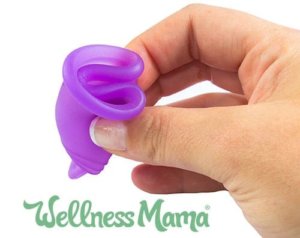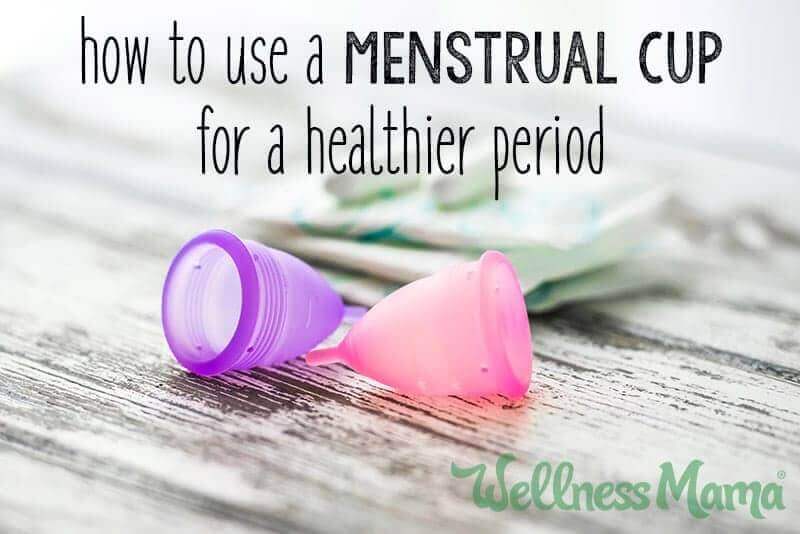Periods can be a big problem. But not for the reasons TV commercials try to convince us they are.
Sure, some women have uncomfortable and painful periods (see info on that at the bottom of this post), but there are some other big problems with the “norm” when it comes to periods. Mainly:
Risks of Tampons and Pads
Most feminine hygiene options like pads and tampons contain harmful chemicals and pesticides that aren’t good in general. While unhealthy, they are especially problematic for the delicate and highly vascular area like the vagina. With once a month use for all of a woman’s child-bearing years, the chemical exposure builds up!
There are also health concerns like Toxic Shock Syndrome (TSS) from tampons and any absorbative products.
Unhealthy for the Planet
Health ramifications aside, options like pads and tampons aren’t good for the planet. Each woman will use an estimated 16,000 pads or tampons in her lifetime. These products end up in landfills, taking years and years to break down.
Most also contain plastic, which isn’t good for humans, but is also pretty terrible for the environment too.
Let me guess, right now, you may be thinking that you are just one person and you only contribute a small number of pads or tampons to the landfills.

But did you know:
Each year, more than 12 BILLION sanitary pads and 7 BILLION tampons are dumped into landfills?
An average woman menstruates for over 40 years, leaving hundreds of pounds of disposable products in landfills.
Natural Period & Tampon Alternatives (That Work Better)
Fortunately, there are some great, organic and green alternatives to toxic, plastic containing disposables now. Most women shell out $5-14 per cycle on disposable products, so these options can save a lot of money over time!
If you haven’t already, consider switching to one of these. Not only are they healthier… but all of these options work better and are more comfortable than traditional pads and tampons. Plus you’ll save money too! A win:win for sure! And if you’re just not a menstrual cup person you can try period underwear.
Menstrual Cups
It took me a while to try these, but I’m so glad I did! Here’s my review of popular brands:
The Diva Cup
As you may gather from its name, the Diva Cup is a silicone cup that is inserted vaginally and it takes the place of tampons and pads during your period. There are two sizes, one for pre-childbearing years and one for after you’ve had a child (or two or three or six…).
Unlike tampons, there is no danger of Toxic Shock Syndrome with the Diva Cup (or any menstrual cup) and it is completely reusable. It can be boiled to sanitize or washed with drinking water. Many women also report that it is much more comfortable, and most only have to change it every 8-12 hours, which is more convenient.
Luna Cup
The Diva Cup was the original, but there are now dozens of great menstrual cup options. Recently I had to purchase another menstrual cup when I was traveling and forgot to pack my Diva Cup. I got this Luna Cup and I have to say I actually like it a little better than the Diva Cup.
I should also put in my personal plug for menstrual cups in general. I’ll admit, when I first found out about them, I thought they were odd and couldn’t imagine using one. Now, I can’t imagine not using one. I’ve worn them overnight, on international flights, while scuba diving, while hiking 20+ miles, and in many other unusual situations. I have never had a leak or a problem and it has never been uncomfortable. Really.
In fact, since my periods are pretty light, I only have to dump the cup once a day, which is super convenient. In many ways, I don’t even notice being on my period now as I can go from gym to swimming to bed without having to change anything.
The first couple of uses it does take a little getting used to, but after that, it really is easier. Give them a try if you haven’t already!
Tips for Using a Menstrual Cup
 Here’s the cheat sheet I wish I’d had on how to use a menstrual cup without the learning curve:
Here’s the cheat sheet I wish I’d had on how to use a menstrual cup without the learning curve:
- Fold it first. There are dozens of ways to fold a menstrual cup to make it easier to insert. I squeeze mine in half and then fold it into a “C” shape so it easily pops back open once inserted.
- Insert like a tampon. Insert the folded cup like a tampon, angling it to the back of the spine. Make sure it fully unfolds to create a light suction. This suction keeps it from leaking. Check this by running your finger along the side to make sure it has unfolded completely. Pull down slightly if needed to make it more comfortable.
- Learn how long. How long you can wear a cup depends on how heavy your cycle is. The good news is that many women find their cycles get lighter and easier when they start using a cup. Like I said, I can wear mine for 24 hours, but the average seems to be about 12.
- Remove, clean and reuse. Wash your hands really well and pull down on the stem of the menstrual cup to release it. Once you’ve pulled it down slightly, gently push on one side to release the suction and carefully remove. Empty into the toilet and wash well with warm water before reinserting.
- When in doubt, turn inside out. This is a tip I learned from my midwife. If it is uncomfortable or you have trouble with leaks, turn the cup inside out. It works like a charm, and is really comfortable this way. It is slightly harder to remove, so just use your pelvic floor muscles to gently push it down to remove it.
Cloth Menstrual Pads
If a menstrual cup is not your thing, there are also a lot of options for cloth menstrual pads. These are more comfortable than plastic based pads! They have a waterproof liner so they don’t leak through clothes and are washable so they are eco-friendly too.
My favorites are these handmade cloth menstrual pads from a local family-owned business (they can ship them worldwide!). They’re handmade by busy midwives and are great cloth pads that have lasted me for years and years!
Organic Menstrual Pads
If the idea of a menstrual cup or cloth pads isn’t your thing, it is possible to find organic disposable tampons or disposable pads so you can at least avoid the chemicals in the conventional versions.
Sea Sponge Tampons
Another great completely natural option is Sea Sponge tampons. They work similarly to a Diva Cup and collect flow. When removed, they can be easily rinsed out a re-used. These are the ones I’ve tried. I personally found them less comfortable than cloth pads or a cup though.
Natural Period Pain Relief
Tylenol and other acetaminophen-based pain relief options are chemically based and emerging research is finding that they are toxic to your mitochondria (you need those little guys!). Luckily, there are a lot of natural options out that, and you can also address the underlying problem and not just mask the pain.
- Vitex – A fertility aid that also helps ease menstrual cramps by balancing hormones. It is also used by herbalists for increasing fertility, though it should be discontinued when a woman becomes pregnant. When not pregnant, it can be taken daily in capsule form or tincture form. For a full explanation of vitex and its benefits, see this post.
- Red Clover – Another herb that is supportive of menstrual health and function. It has been known to ease endometriosis and PCOS and is helpful for cramps. It should also be discontinued when a woman becomes pregnant. When not pregnant, it can be taken daily. I’ve tried this brand.
- Progesterone Cream – A natural progesterone cream is perhaps the best remedy, long-term for many menstrual problems. I’ve had many clients conceive by adding progesterone to their regimen, and it also helps ease cramps. Many menstrual problems can be caused or exacerbated by too much estrogen in the body, and progesterone helps balance it out. If used, it should only be used in the second half of the cycle (ovulation until start of the period) and applied to the skin of fatty areas of the body like the thighs, buttocks, stomach, breasts and upper arms. I’ve used this brand in the past but recently switched to this one on Dr. Anna Cabeca’s recommendation in this podcast.
- Magnesium – Taking magnesium regularly may also really help ease cramps (and there are a lot of other benefits to taking magnesium too!) My favorite brand by far is this time-release formula. Read more about magnesium in this post.
- Homeopathy – Our medical reviewer Dr. Madiha recommends a homeopathic product called Cyclease and uses it herself. If you’re curious, I wrote a whole post about homeopathetic remedies here.
This article was medically reviewed by Madiha Saeed, MD, a board certified family physician. As always, this is not personal medical advice and we recommend that you talk with your doctor.
This article was medically reviewed by Dr. Betsy Greenleaf, an ON/GYN and board certified urogynecologist. As always, this is not personal medical advice and we recommend that you talk with your doctor.
Do you have any natural tips for dealing with feminine health? Ever used any of the suggestions above? Please let me know below!


Leave a Reply